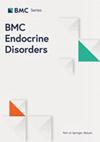Dietary nitrate maintains homeostasis of oxidative stress and gut microbiota to promote flap survival in type 2 diabetes mellitus rats
IF 2.8
3区 医学
Q3 ENDOCRINOLOGY & METABOLISM
引用次数: 0
Abstract
Random-pattern skin flaps are commonly used to repair skin tissue defects in surgical tissue reconstruction. However, flap necrosis in the distal area due to ischemia injury is still challenging for its applications in plastic surgery. The complications of diabetes will further increase the risk of infection and necrosis. This study induced type 2 diabetes mellitus (T2DM) rats with a high-fat diet and STZ. The survival rate of the skin flap was observed by adding inorganic sodium nitrate to drinking water. Histology and immunohistochemistry were used to detect the damage to the skin flap. The nitrate content was measured by total nitric oxide and nitrate/nitrite parameter assay. Dihydroethidium and malondialdehyde (MDA) assays were used to value oxidative stress. Rat colon feces were collected for 16s rRNA gene sequence. Our studies showed that nitrate administration leads to anti-obesity and anti-diabetic effects. Nitrate directly increased the survival area of skin flaps in diabetic rats and mean blood vessel density by enhancing angiogenesis, inhibiting apoptosis, and reducing oxidative stress. The 16s rRNA sequence revealed that nitrate may regulate the homeostasis of the gut microbiota and re-store energy metabolism. Dietary nitrate has been shown to maintain the homeostasis of oxidative stress and gut microbiota to promote flap survival in rats with T2DM.膳食硝酸盐可维持氧化应激和肠道微生物群的平衡,从而促进 2 型糖尿病大鼠的瓣膜存活率
随机模式皮瓣常用于修复外科组织重建中的皮肤组织缺损。然而,由于缺血损伤导致的皮瓣远端坏死仍是其在整形外科应用中面临的挑战。糖尿病并发症会进一步增加感染和坏死的风险。本研究以高脂肪饮食和 STZ 诱导 2 型糖尿病(T2DM)大鼠。通过在饮用水中添加无机硝酸钠,观察皮瓣的存活率。采用组织学和免疫组织化学方法检测皮瓣受损情况。总一氧化氮和硝酸盐/亚硝酸盐参数测定法检测硝酸盐含量。二氢乙二胺和丙二醛(MDA)测定法用于评估氧化应激。收集大鼠结肠粪便以测定 16s rRNA 基因序列。我们的研究表明,硝酸盐具有抗肥胖和抗糖尿病的作用。硝酸盐通过促进血管生成、抑制细胞凋亡和减少氧化应激,直接增加了糖尿病大鼠皮瓣的存活面积和平均血管密度。16s rRNA 序列显示,硝酸盐可调节肠道微生物群的平衡并重新储存能量代谢。研究表明,膳食硝酸盐可维持氧化应激和肠道微生物群的平衡,从而促进 T2DM 大鼠的瓣膜存活。
本文章由计算机程序翻译,如有差异,请以英文原文为准。
求助全文
约1分钟内获得全文
求助全文
来源期刊

BMC Endocrine Disorders
ENDOCRINOLOGY & METABOLISM-
CiteScore
4.40
自引率
0.00%
发文量
280
审稿时长
>12 weeks
期刊介绍:
BMC Endocrine Disorders is an open access, peer-reviewed journal that considers articles on all aspects of the prevention, diagnosis and management of endocrine disorders, as well as related molecular genetics, pathophysiology, and epidemiology.
文献相关原料
| 公司名称 | 产品信息 | 采购帮参考价格 |
|---|
 求助内容:
求助内容: 应助结果提醒方式:
应助结果提醒方式:


